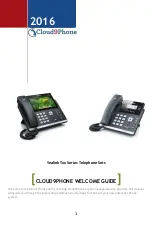
Basic Call Features
145
Response Groups
If you sign into the phone using Onprem account, you can use response groups feature. Current
Online environment does not support this feature.
If your organization has groups of people who answer and manage certain types of calls, such as
for customer service, an internal help desk, or general telephone support for a department, you
can deploy the Response Group application to manage these types of calls. The Response
Group application routes and queues incoming calls to designated persons, who are known as
agents. You can increase the use of telephone support services and reduce the overhead of
running these services by using response groups.
When a caller calls a response group, the call is routed to an agent based on a hunt group or the
caller's answers to interactive voice response (IVR) questions.
If no agents are available, the call is held in a queue until an agent is available. While in the
queue, the caller hears music until an available agent accepts the call. If the queue is full, or if
the call times out while in the queue, the caller might hear a message and then is either
disconnected or transferred to a different destination, such as a different phone number or
voicemail.
The Response Group application uses standard response group routing methods to route the
call to the next available agent. The system administrator can configure the routing methods of
response group on the Skype for Business Server.
The routing methods of response group are as follows:
Longest idle
method: The call is routed to the agent who has the longest idle time.
If the agent is unavailable, the call goes into the next agent who has the longest idle time
until the call is answered.
Parallel
method: The call is routed to all idle agents.
All idle agents are called at the same time for every incoming call.
Round robin
method: The call is routed to the agent ordered by agent list circularly.
If the agent is unavailable, the call goes into the next agent ordered by agents list circularly
until the call is answered or the agent list end.
Serial
method: The call is routed to the agent ordered by agents list orderly.
If the agent is unavailable, the call goes into the next agent ordered by agents list orderly
until the call is answered.
Attendant
method: The call is routed to the agents who sign into Skype for Business
Server or response group.
All agents are called at the same time for every incoming call, regardless of their current
presence.
















































